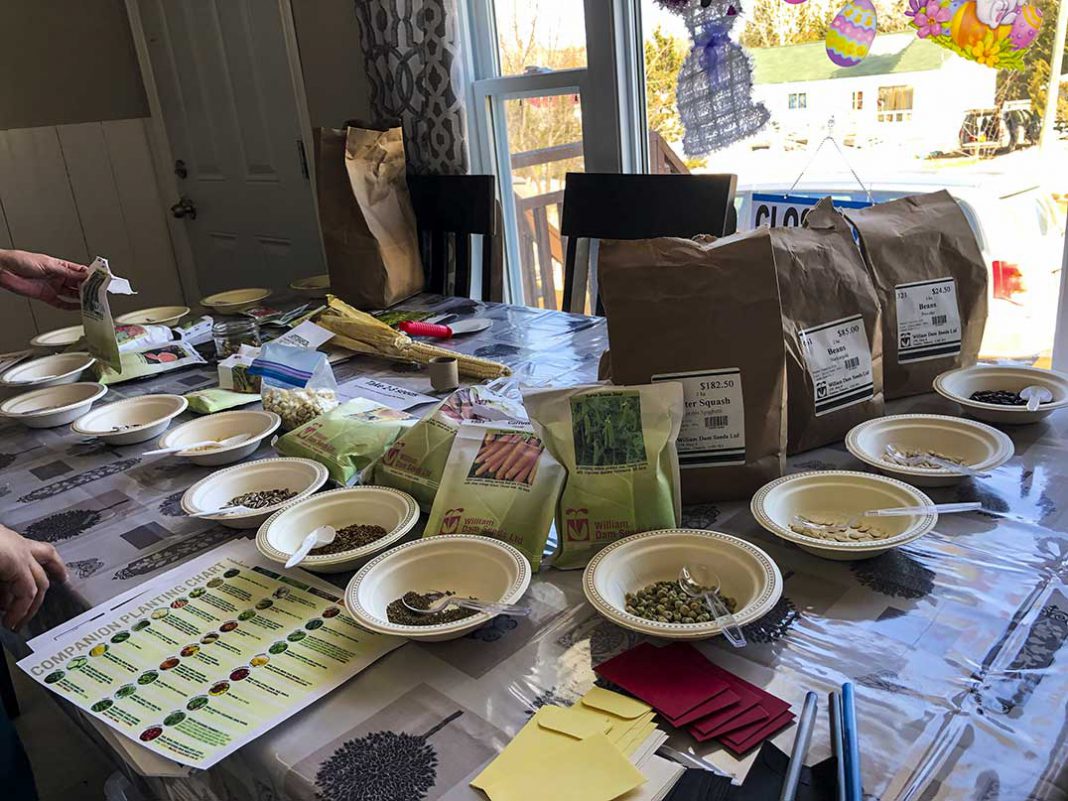WIIKWEMKOONG—Last week Linda Willson of Ice Lake and Anastasia Eranosova of Tehkummah were making the rounds across Manitoulin, giving beginner gardeners tips and tricks on starting seeds, to planting and planning one’s garden in a series of workshops hosted by Noojmowin Teg and the Manitoulin Community Fresh Food Initiative.
After an introduction by both gardeners, Ms. Eranosova began the talk with a focus on starting plants from seeds.
“From shrubs to trees to fruits and vegetables, gardening is the most hopeful and optimistic of occupations,” she told the Wiikwemkoong group, adding that seeds are begun often while there is still snow on the ground.
Starting seeds is not only a cheaper way to garden, but it also provides for a great deal of satisfaction and seeing something through from start to finish.
When choosing a seed company, both Ms. Eranosova and Ms. Willson recommend going with small, local (Ontario) seed companies such as OSC (Ontario Seed Company), William Dam Seeds, Matchbox Garden Seed Co. and, the favourite of fundraising groups, Vesey’s, as some examples.
Ms. Eranosova explained that February and March are when the planning stages for gardens should begin and recommended that seed catalogues be ordered at this time.
There are two types of seeds: hybrid, meaning two parent varieties have been crossed to create an offspring with one or more ‘tolerable’ traits; and open pollinated, which have offspring that have similar traits to the parents. There are some organics available in open pollinated seeds. Within the open pollinated category falls heirloom seeds, which are old time varieties and seeds that have parentage over 60 years. These provide for stronger plants.
A disadvantage of hybrid seeds, Ms. Eranosova explained, is that the seeds cannot be saved for future use as they will not germinate and produce a new plant.
To start, the seven easiest vegetables to grow are: lettuce and other greens, tomatoes, cucumbers, radishes, beans, zucchini and marigolds (for pest control). It’s a good idea to plant flowers among your garden to attract much-needed pollinators.
Ms. Eranosova said that most seeds require two to eight weeks of indoor growing time. It’s important to know when, according to your climate zone, the last of the frost-free days is expected and to plan accordingly. (For much of Manitoulin, that usually occurs around May 24, but for places like Sheshegwaning and other Western Manitoulin communities that can be early June.) There are no less than five climate zones on Manitoulin!
Grab a calendar and count backwards from that estimated frost free day (the Farmers’ Almanac is good place to look for that estimate) and start your seeds accordingly.
An economical way to start your seeds is to use egg cartons, toilet paper tubes (with the bottoms folded in) or even egg shells. All of these items can be direct-planted too and will compost on their own. If using a toilet paper tube, make sure it’s brown. White ones contain bleach, which you don’t want in your garden. Plastic cell packs, available at all hardware stores, are also an option.
Whatever vessel you choose, be sure to plant two or three seeds in each.
Drainage for your seedlings is incredibly important so be sure to have perlite or vermiculite in your seed starter and compost is a good idea too. Neither Ms. Willson nor Ms. Eranosova recommend using peat moss due to the harvesting practices surrounding it and the effect it’s having on the ecosystem from which it’s taken. While you can purchase seed starting mix, the following is a recipe to do it yourself:
Seed Starting Mix
4 parts fish (like Meeker’s Magic Mix), mushroom or sheep compost
2 parts coconut fibre
1 part perlite
1 part vermiculite
Mix well, add water and get planting.
Fill your cell/eggshell/tube with seed starter mix, leaving half an inch below the top rim. Plant the seed twice as deep as the size of the seed and place the plastic tray overtop. If on a municipal water system, be sure to leave watering can water out for at least two days to allow the chlorine to evaporate and be sure to use a fine spray water can, but watering from the bottom is the recommended means of giving your seedlings a drink.
Your seeds then need to be kept in the dark until they begin to germinate. If you don’t have a dark room, place a dishtowel over the cells.
“Plants need 12 to 16 hours of light each day,” Ms. Eranosova explained. “So even the sunniest window means they will still need more light.”
Artificial light for your seedlings is crucial. Ms. Eranosova recommends LED for the range of light it offers as well as the related electricity bill cost-savings. Artificial lights should be kept between three and four inches from the top of your plant.
On a warm sunny day, crack open your window and let your seedlings get a taste of things to come. In a few weeks, give them a light meal, Ms. Eranosova recommended.
When your seedlings get leaves, it’s time to transplant them to a bigger pot.
By now it’s mid to late May and warmer temperatures are (hopefully) upon us. It’ time to acclimatize the plants to outside temperatures and more light.
Ms. Eranosova suggested beginning with two to three hours and steadily increasing their time in the elements.
Ms. Eranosova urged new gardeners to be on the lookout for three issues that seedlings might face. ‘Damping off’ means there’s too much moisture in the soil. It is for this reason that watering from the bottom is recommended. Leggy seedlings are plants that ‘have stem for days’ and very few leaves, which means they are not getting enough light or are too crowded and competing for a light source. Leaves that are browning around the edges or are curly mean they are either nutrient deficient or are getting too many nutrients.
EDITOR’S NOTE: See future editions of this newspaper for Part II of this feature and getting your garden ready to plant with Linda Willson.





